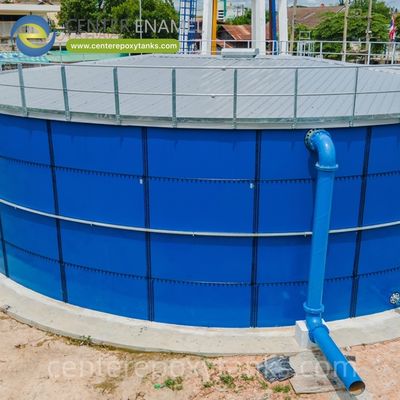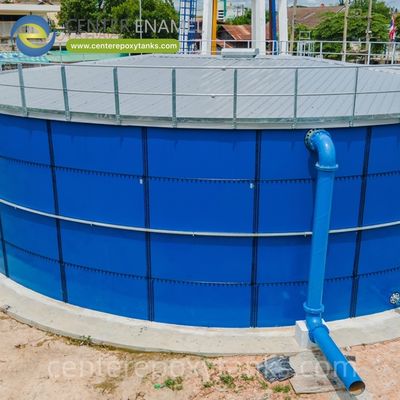-
Glas gesmolten met stalen tanks (419)
-
roestvrij staaltanks (372)
-
De fusie plakte Epoxytanks (424)
-
Gegalvaniseerde stalen tanks (321)
-
De Daken van de aluminiumkoepel (753)
-
Opbergtanks voor afvalwater (226)
-
gelaste stalen tanks (297)
-
Drukvaten (295)
-
Anaërobe Autoclaaf (201)
-
Industriële Watertanks (349)
-
Gelaagde stalen tanks (180)
-
Vastgeboute Staaltanks (181)
-
De Tank van de modderopslag (115)
-
De Tank van de biogasopslag (173)
-
Leachatopslagtanks (133)
-
Landbouwwateropslagtanks (179)
-
Brandwatertank (166)
-
Graanopslagplaatsen (130)
-
Biogas projecten (349)
-
Waterzuiveringsinstallatieprojecten (270)
-
Doppel membraan dak (177)
Epoxytank voor textiel- en zetmeelafval: een veelzijdig vat voor gemengd industrieel afvalwater
| Plaats van herkomst: | China |
| Merknaam: | CEC TANKS |
| Certificering: | ISO 9001:2008, AWWA D103 , OSHA , BSCI |
| Modelnummer: | W201691123005 |
| Min. bestelaantal: | 1Set |
| Prijs: | $5000~$20000 one set |
| Verpakking Details: | PE poly-foam tussen elke twee stalen platen; houten pallet en houten doos |
| Levertijd: | 0-60 dagen nadat de storting is ontvangen |
| Betalingscondities: | L/c, t/t |
| Levering vermogen: | 60 sets per maand |
|
Detailinformatie |
|||
| Plaats van herkomst | China | Merknaam | CEC TANKS |
|---|---|---|---|
| Certificering | ISO 9001:2008, AWWA D103 , OSHA , BSCI | Modelnummer | W201691123005 |
| Stalen platen dikte: | 3 mm tot 12 mm, hangt af van de tankstructuur | Corrosie -integriteit: | Uitstekend |
| Chemische weerstand: | Uitstekend | Capaciteit: | 20 m3 tot 18.000 m3 |
| Leven in dienst: | ≥30 jaar | Permeabiliteit: | Gas / vloeistof ondoordringbaar |
| Markeren: | Fusie gebonden epoxy afvalwatertank,textielzetmeel afvoertenk,industriële gemengde afvalwatervaten |
||
Productbeschrijving
Fusion Bonded Epoxy Tank voor textiel- en zetmeelafvalwater: een veelzijdig vat voor gemengd industrieel afvalwater
Industriële zones en gemengde productie-installaties staan vaak voor de lastige taak van het beheer van gemengd industrieel afvalwater, een uitdagende combinatie van afvalstromen met sterk verschillende chemische eigenschappen. Een goed voorbeeld is de vermenging van textiel- en zetmeelafvalwater. Textielafvalwater bevat giftige kleurstoffen, zware metalen en sterke verwerkingschemicaliën, terwijl zetmeelafvalwater een extreem hoge concentratie van gemakkelijk fermenteerbare organische belasting (hoog ZBO) bijdraagt. Het succesvol bevatten en voorbehandelen van deze complexe mix vereist een containmentoplossing die zeer duurzaam, chemisch resistent en veelzijdig is. Het moet echt een veelzijdig vat voor gemengd industrieel afvalwater zijn. De Fusion Bonded Epoxy (FBE) Tank is uniek geschikt voor deze veeleisende omgeving. Bij Shijiazhuang Zhengzhong Technology Co., Ltd. (Center Enamel) ontwikkelen we FBE-stalen tanks met boutverbindingen om een structureel robuust en chemisch inert platform te bieden, waardoor stabiele egalisatie en voorbehandeling voor de meest complexe industriële afvalwaterstromen worden gegarandeerd.
De dubbele uitdagingen van gemengd industrieel afvalwater
De combinatie van textiel- en zetmeelafvalwater creëert synergetische uitdagingen die de moeilijkheid van containment en behandeling intensiveren:
Chemische en organische volatiliteit: De mix combineert de chemische toxiciteit, hoge pH (van verven) en kleur van textielafval met de explosieve organische belasting en snelle verzuring (lage pH) van zetmeelafval. Containment moet bestand zijn tegen snelle en extreme pH-schommelingen en de corrosieve werking van zowel chemische residuen als organische zuren.
Hoge en variabele ZBO-belasting: Terwijl de zetmeelcomponent de uitzonderlijk hoge ZBO-afvalwater dicteert, kan textielafval hoge niveaus van bindmiddelen (vaak zetmelen zelf) en afwerkingschemicaliën bevatten. Dit vereist een robuust, veelzijdig vat met hoge capaciteit voor egalisatie om schokbelastingen op biologische behandelingsinstallaties te voorkomen.
Kleurstof- en chemische resistentie: De FBE-voering moet bestand zijn tegen vlekken en chemische degradatie van de agressieve synthetische kleurstoffen, bleekmiddelen en metaalkatalysatoren die worden gebruikt bij textielafwerking, waardoor de tank zijn structurele integriteit behoudt, ongeacht de chemische inhoud van het afvalwater.
Structurele eisen van egalisatie: De kernfunctie van tanks in gemengde systemen is egalisatie - het mengen en stabiliseren van de stroom en samenstelling. Dit vereist een structureel gezond, vat met hoge capaciteit dat veilig de immense hydraulische belastingen van deze grote mengbassins aankan.
Biologische compatibiliteit: De uiteindelijke oplossing moet inert zijn. Het vat kan geen stoffen uitlogen die de biologische behandeling van het zetmeelafvalwater remmen, dat gevoelig is voor de zware metalen of biociden die vaak in het textielgedeelte aanwezig zijn.
De containmentoplossing moet een veelzijdig vat zijn dat in staat is de chemische agressie van de ene stroom in evenwicht te brengen met de organische belasting van de andere.
De FBE-oplossing: een veelzijdig vat voor gemengd industrieel afvalwater
Center Enamel's Fusion Bonded Epoxy Bolted Steel Tanks zijn ontworpen voor een breed spectrum aan chemische resistentie, waardoor ze een veelzijdig vat voor gemengd industrieel afvalwater zijn, zoals de textiel- en zetmeelafvalwater-combinatie:
Brede chemische en pH-resistentie: De dichte, moleculair gebonden FBE-coating is geformuleerd om bestand te zijn tegen de brede reeks corrosieve stoffen - van de sterke logen en bleekmiddelen van textielprocessen tot de organische zuren van fermenterend zetmeel. Dit zorgt ervoor dat het staal wordt beschermd over het gehele operationele pH-spectrum.
Structurele sterkte voor egalisatie: FBE-tanks, geconstrueerd van hoogwaardig, geconstrueerd staal, bieden de robuuste, hoge capaciteit-structuur die nodig is voor effectieve homogenisatie en menging van grote, variabele stromen van gemengd industrieel afvalwater, waardoor sedimentatie wordt voorkomen en een soepele doorstroming naar downstream-processen wordt gegarandeerd.
Uitstekende anti-aankoeking en niet-vlekkend: Het gladde, niet-poreuze FBE-oppervlak is bestand tegen de hechting van kleverige zetmeeldeeltjes en minimaliseert de penetratie en vlekken van krachtige textielkleurstoffen, waardoor een schoon tankinterieur wordt behouden en de onderhoudskosten worden verlaagd.
Inertheid voor biologische bescherming: Ondanks de chemische complexiteit van de influent, is de FBE-voering niet-uitlogend en inert, waardoor een stabiele interne omgeving ontstaat die de delicate microbiële gemeenschappen in daaropvolgende biologische reactoren beschermt tegen chemische remming.
Modulaire flexibiliteit: FBE-tanks kunnen snel worden opgericht en op exacte specificaties worden afgestemd, waardoor faciliteiten snel dedicated egalisatie kunnen implementeren of uitbreiden, een essentiële stap bij het toevoegen van nieuwe processen (zoals zetmeelmaat) aan bestaande textielbehandelingsinfrastructuur.
Productindustrie-toepassing: FBE-tanks in de verwerking van gemengd afvalwater
De veerkracht en aanpasbaarheid van FBE-tanks maken ze de ideale keuze voor het beheersen van de gecombineerde uitdagingen van textiel- en zetmeelafvalwater in verschillende belangrijke toepassingen:
Egalisatiebassins: De primaire toepassing, waarbij de veelzijdigheid van de tank zorgt voor het veilig mengen en pH-balanceren van het ruwe, vluchtige gemengd industrieel afvalwater vóór de behandeling.
Chemische neutralisatie en opslag: Gebruikt om afzonderlijke stromen van sterk zuur of bijtend waswater en verbruikte verwerkingschemicaliën veilig vast te houden of te neutraliseren voordat ze worden gemengd met de belangrijkste afvalwaterstroom.
Primaire bezinking en flocculatie: FBE-tanks bieden corrosiebestendige vaten voor initiële chemisch ondersteunde flocculatie en bezinking, wat cruciaal is voor het verwijderen van zwevende stoffen en kleur uit textielafvalwater.
Anaerobe vergisting met hoge snelheid (AD): Voor de hoge ZBO-zetmeelcomponent dienen FBE-tanks als robuuste vergisters, die structurele integriteit garanderen tegen H2S-corrosie en chemische residuen, terwijl de biogasproductie wordt gemaximaliseerd.
Ontwatering en opslag van slib: De tanks worden gebruikt voor de veilige opslag van het dichte, chemisch beladen slib dat wordt gegenereerd door de precipitatie en biologische behandeling van het gemengd industrieel afvalwater wordt gewaarborgd.
Projectcasestudies: FBE-tanks in de behandeling van gemengd industrieel afvalwater
Center Enamel heeft robuuste, veelzijdige containmentoplossingen geleverd voor complexe industriële faciliteiten die uitdagende afvalmengsels beheren, wat de capaciteit van de FBE-tank aantoont als een veelzijdig vat voor gemengd industrieel afvalwater wordt gewaarborgd.
| Projectbeschrijving | Projectomvang & hoeveelheid |
| Guangdong Dyeing and Finishing Wastewater Treatment Project | Een belangrijke industriële installatie bestaande uit 2 eenheden met een totale capaciteit van 4.498 kubieke meter, die veelzijdige en chemisch resistente containment biedt voor het veeleisende verfafvalwater. |
| Jiangsu Wuxi Textile and Dyeing Wastewater Project | Deze kritieke infrastructuur maakte gebruik van 2 eenheden met een totale capaciteit van 1.023 kubieke meter, ontworpen voor het gelijktijdig beheer van een hoge organische belasting en corrosieve textielchemicaliën. |
| Fujian Industrial Wastewater Treatment Project | We leverden een robuuste oplossing bestaande uit 2 eenheden met een totale capaciteit van 1.226 kubieke meter, ingezet voor de veilige verwerking van verschillende, gemengde industriële chemische en organische afvalstromen. |
De rol van Center Enamel in complexe industriële compliance
Shijiazhuang Zhengzhong Technology Co., Ltd. (Center Enamel) zet zich in voor het leveren van infrastructuur die complexe industriële compliance vereenvoudigt en operationele levensduur garandeert. Onze FBE-tanks voor textiel- en zetmeelafvalwater worden vervaardigd onder strikte kwaliteitscontrole, wat een moleculair gebonden, hoogwaardige coating garandeert die een breed spectrum aan chemische bescherming biedt. Door te kiezen voor Center Enamel investeren klanten in een veelzijdig vat dat de dubbele bedreiging van chemische agressie en hoge organische belasting beheert, waardoor de stabiele, conforme behandeling van hun gemengd industrieel afvalwater wordt gewaarborgd.
Conclusie: de basis voor complex afvalbeheer
Het beheer van gemengd industrieel afvalwater van bronnen zoals textiel- en zetmeelafvalwater vereist een oplossing die structureel gezond en chemisch aanpasbaar is. De Fusion Bonded Epoxy Tank, met zijn hoge structurele veerkracht, uitzonderlijke chemische resistentie en niet-poreuze oppervlak, is het definitieve veelzijdige vat voor gemengd industrieel afvalwater. Het biedt de robuuste, betrouwbare basis die nodig is voor de cruciale egalisatie en behandeling van de meest uitdagende afvalwaterstromen, waardoor veiligheid, efficiëntie en langdurige milieucompliance worden gegarandeerd.
Om een containment-systeem te implementeren dat is ontworpen voor de veelzijdigheid en veerkracht die nodig zijn om complexe gemengde industriële afvalwater te beheren, kiest u de Fusion Bonded Epoxy Bolted Steel Tanks van Center Enamel. Neem vandaag nog contact met ons op om uw essentiële industriële infrastructuur veilig te stellen.




